Distant Thunder: The Crisis Coming in Korea

The world is not going to step aside and wait while the Congress ponders the fate of the president of the United States. Events of greater magnitude in the long term will grind ahead thousands of miles away from the impeachment proceedings in Washington. In the next few months the situation in Korea, where a nuclear-armed DPRK is terrifyingly close to developing intercontinental-range ballistic missiles (ICBMs) capable of carrying thermonuclear warheads, could go from very bad to much, much worse.
To review: In June 2018, when US President Trump met with the DPRK leader Kim Jong Un, there was actually a chance to begin a sensible and effective approach to North Korea. That would not have led to quick satisfaction of US demands for the North’s denuclearization, but it could at least have put in place a process to begin scaling back the threat and enhancing overall stability on the peninsula so that today there would be some guardrails in place.
Over the past eight months, since the failed Hanoi Summit last February, that opening appears to have narrowed to near nothing. The outcome of the October 5 meeting in Stockholm suggests it may already have disappeared. If Pyongyang has decided it has a viable option to move to full and final development of its most fearsome weapons while the US sinks into months of savage internal political warfare, then East Asia, in fact the entire Western Pacific, will in a flash become more dangerous than it has been at any time since World War II.
Here is the reality. North Korea likely already has an arsenal of nuclear weapons and the means to deliver them throughout much of Northeast Asia. That is the result of an effectively planned and executed development program since 2002, one unhindered by the feckless policies and ineptness of two US administrations. Sanctions, even at the level of “maximum pressure,” never had a chance of pushing Pyongyang to reverse its nuclear weapons program, much less give it up. The North Korean economy, for reasons economists cannot grasp, has not slid precipitously downhill. Over the past several years, economic, and to some extent, social change—whether from top down or from the bottom up is irrelevant—has not unhinged the system but extended its life. The North Korean leader, much mocked by Western observers, is beginning his ninth year. International fulminating against the North’s human rights situation has gained us nothing and, what is worse, has done nothing to help the victims. Seoul has no leverage, Tokyo is inept and neither Beijing nor Moscow can bring the Pyongyang to heel. Indeed, the image of Xi Jinping or Vladimir Putin tugging at an imaginary leash and telling Kim, “Sit, dammit, sit,” is laughable.
During the last impeachment, I was in the US State Department as an adviser on the US team negotiating with Pyongyang. It was a very good team, led by a supremely smart and able diplomat, Ambassador Charles Kartman. Nevertheless, by September 1998, US engagement with the North looked to be on its last legs, not least because the White House had lost its focus. Virtually on its own, the negotiating team worked to keep at least some buoyancy in talks with the North. To an extent we were lucky, the political atmosphere in Washington, while toxic and divisive, was nothing like it is today. Moreover, the months of the impeachment process pretty much coincided with a heaven-sent opportunity for an intellectually honest and far-reaching North Korea policy review led by former US Secretary of Defense William Perry. Thanks to the Perry review, we emerged with a significantly stronger, more effective basis for the policy as well as renewed energy in our engagement with the North.
Even so, in the end, our biggest problem became one of timing. Largely because of North Korean miscalculation, we ran out of time with the November 2000 elections.
Now, again, it looks as if we are out of time. Yet there is an enormous difference between the situation then and what we face today. In 2000, there was still space for the next administration to recover. The Bush administration, thanks not least to John Bolton, squandered the opportunity. At that point, let’s be crystal clear, the North had zero nuclear weapons, was six years away from its first test and its fissile material production center at Yongbyon was frozen. It had only a nascent clandestine centrifuge program.
Today, we are out of both time and space. The North already has an arsenal estimated at 40 nuclear weapons; it has already carried out six nuclear tests; its fissile material production facilities at Yongbyon and elsewhere are, as far as we know, all operating and producing more and more bomb fuel.
Standing on this cliff’s edge, how do we stop from falling off?
First, we have to focus on the fact that amidst and in some ways because of the current developments in domestic American politics, we are entering a very dark period internationally. To repeat a key point, if Washington is on the verge of paralysis, the rest of the world—most especially North Korea—is not.
Once we’re sufficiently sobered by that realization, then even amid our political crisis we have to think seriously and with great precision about how bad things can get with North Korea in the next six to twelve months. Only if we do that can we take the measure of how unprepared we are to cope—not in terms of military strength and ability, but rather in terms of national will and understanding of the real options and the consequences of so many years of bad decisions.
At that point, and only then, can we begin to grasp the enormity of what we face, and what we may have to do.
